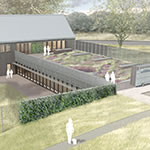Several decades ago, overzealous road building in Baltimore cut off a triangular, nine-acre section of a circa-1860 park, rendering it useless and allowing a 19th-century stone home to be gradually consumed by vegetation. To begin a 21st-century reclamation and renovation of the home and site—which, with the addition of two new buildings, is expected to become the LEED Platinum-certified headquarters for Baltimore’s Parks & People Foundation—the project developers hired an usual group: goats.
“The site was overgrown with vines and poison ivy,” recalls Steve Ziger, a principal at Ziger/Snead Architects, the firm overseeing the revitalization of the site and buildings, known as Druid Hill Park at Auchentoroly Terrace. “Goats eat everything in an environmentally friendly way.”


Only once the vines around the existing building (formerly the park superintendent’s home) were gone could the firm analyze the integrity of the structure. There was good reason to be wary: The entire roof and interior floors had collapsed from neglect and fires, and some of the exterior walls were in bad shape as well. Project leadership had to prove to the Maryland Historical Trust that the building was salvageable.
But Ziger, along with Parks & People, which is helping restore the property, persevered. The team was able to keep the exterior walls (with tuck-pointing and bracing), restyle the interior to serve Parks & People’s needs, and even recreate gingerbread trim from what was found in the ruins and old photographs.


The pending LEED Platinum certification is in keeping with Parks & People’s mission. The 30-year-old nonprofit links natural urban resources with the physical and social needs of city residents. By headquartering itself in this economically challenged neighborhood—the community adjacent to the site has an average household income of less than $25,000 per year—staff and resources are better linked to much of what the organization stands for. “This is central to the city and yet part of a real neighborhood,” says Ziger, who also serves on the foundation’s board of directors.
The campus, which will house 50 employees plus visitors and volunteers and offer a publicly accessible ecology center, reading rooms, demonstration gardens, and walking paths, is at a confluence of several public transportation lines, bike and pedestrian trails, and a linkage of parks and green spaces that make up Baltimore’s “One Park” system.


The renovated building and an adjacent carriage house achieved several environmental goals. Of 200 existing trees on site, a majority of the healthy trees were preserved. Geothermal wells support interior climate controls, solar panels heat the water, and reclaimed and rapidly renewable wood is being used for cladding and solar shading. Community composting is in development while demonstration gardens and walking paths serve important education functions.
Stormwater management is a particularly important part of this program. On its hilly site, the nine-acre property falls within the Chesapeake Bay watershed, subject to stringent Maryland standards for reducing toxic runoff into that fragile ecosystem. The project goes above and beyond to capture stormwater on site, surpassing mandates with several tactics. Installed at various points on and around the buildings were five separate bioretention facilities, a vegetated roof, rainwater-harvesting cisterns, porous paving, reinforced turf, and a sand filter. Requirements for water quality and groundwater recharge volumes—measures of how water is held and discharged via the natural aquifer—were surpassed by more than 90 percent, according to STV, the project’s lead civil engineer.
Finally, about a quarter mile of one street lane on the perimeter of the project, that same street that cut the area off several decades ago, was converted to bike lanes and bioretention facilities to treat stormwater runoff. It turns out those wide streets were overbuilt all along.
Read our Q&A with Steve Ziger.

